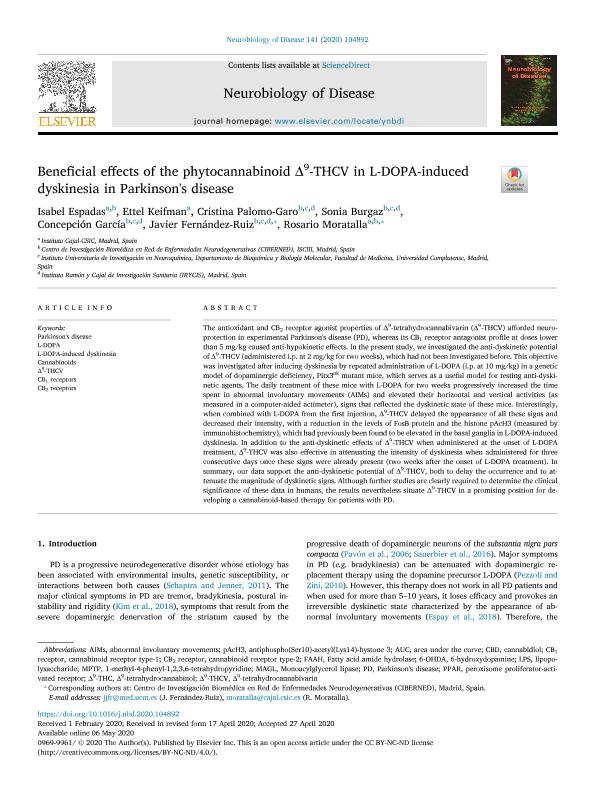Mostrar el registro sencillo del ítem
dc.contributor.author
Espadas, Isabel
dc.contributor.author
Keifman, Ettel

dc.contributor.author
Palomo Garo, Cristina
dc.contributor.author
Burgaz, Sonia
dc.contributor.author
García, Concepción
dc.contributor.author
Fernández Ruiz, Javier
dc.contributor.author
Moratalla, Rosario
dc.date.available
2021-04-12T12:14:40Z
dc.date.issued
2020-07
dc.identifier.citation
Espadas, Isabel; Keifman, Ettel; Palomo Garo, Cristina; Burgaz, Sonia; García, Concepción; et al.; Beneficial effects of the phytocannabinoid Δ9-THCV in L-DOPA-induced dyskinesia in Parkinson's disease; Academic Press Inc Elsevier Science; Neurobiology of Disease; 141; 7-2020; 1-10
dc.identifier.issn
0969-9961
dc.identifier.uri
http://hdl.handle.net/11336/129814
dc.description.abstract
The antioxidant and CB2 receptor agonist properties of Δ9-tetrahydrocannabivarin (Δ9-THCV) afforded neuroprotection in experimental Parkinson's disease (PD), whereas its CB1 receptor antagonist profile at doses lower than 5 mg/kg caused anti-hypokinetic effects. In the present study, we investigated the anti-dyskinetic potential of Δ9-THCV (administered i.p. at 2 mg/kg for two weeks), which had not been investigated before. This objective was investigated after inducing dyskinesia by repeated administration of L-DOPA (i.p. at 10 mg/kg) in a genetic model of dopaminergic deficiency, Pitx3ak mutant mice, which serves as a useful model for testing anti-dyskinetic agents. The daily treatment of these mice with L-DOPA for two weeks progressively increased the time spent in abnormal involuntary movements (AIMs) and elevated their horizontal and vertical activities (as measured in a computer-aided actimeter), signs that reflected the dyskinetic state of these mice. Interestingly, when combined with L-DOPA from the first injection, Δ9-THCV delayed the appearance of all these signs and decreased their intensity, with a reduction in the levels of FosB protein and the histone pAcH3 (measured by immunohistochemistry), which had previously been found to be elevated in the basal ganglia in L-DOPA-induced dyskinesia. In addition to the anti-dyskinetic effects of Δ9-THCV when administered at the onset of L-DOPA treatment, Δ9-THCV was also effective in attenuating the intensity of dyskinesia when administered for three consecutive days once these signs were already present (two weeks after the onset of L-DOPA treatment). In summary, our data support the anti-dyskinetic potential of Δ9-THCV, both to delay the occurrence and to attenuate the magnitude of dyskinetic signs. Although further studies are clearly required to determine the clinical significance of these data in humans, the results nevertheless situate Δ9-THCV in a promising position for developing a cannabinoid-based therapy for patients with PD.
dc.format
application/pdf
dc.language.iso
eng
dc.publisher
Academic Press Inc Elsevier Science

dc.rights
info:eu-repo/semantics/openAccess
dc.rights.uri
https://creativecommons.org/licenses/by-nc-nd/2.5/ar/
dc.subject
CANNABINOIDS
dc.subject
CB1 RECEPTORS
dc.subject
CB2 RECEPTORS
dc.subject
L-DOPA
dc.subject
L-DOPA-INDUCED DYSKINESIA
dc.subject
PARKINSON'S DISEASE
dc.subject
Δ9-THCV
dc.subject.classification
Neurociencias

dc.subject.classification
Medicina Básica

dc.subject.classification
CIENCIAS MÉDICAS Y DE LA SALUD

dc.title
Beneficial effects of the phytocannabinoid Δ9-THCV in L-DOPA-induced dyskinesia in Parkinson's disease
dc.type
info:eu-repo/semantics/article
dc.type
info:ar-repo/semantics/artículo
dc.type
info:eu-repo/semantics/publishedVersion
dc.date.updated
2021-03-26T19:55:48Z
dc.journal.volume
141
dc.journal.pagination
1-10
dc.journal.pais
Estados Unidos

dc.description.fil
Fil: Espadas, Isabel. INSTITUTO CAJAL ; CONSEJO SUPERIOR DE INVESTIGACIONES CIENTIFICAS;
dc.description.fil
Fil: Keifman, Ettel. INSTITUTO CAJAL ; CONSEJO SUPERIOR DE INVESTIGACIONES CIENTIFICAS; . Consejo Nacional de Investigaciones Científicas y Técnicas. Oficina de Coordinación Administrativa Houssay. Instituto de Fisiología y Biofísica Bernardo Houssay. Universidad de Buenos Aires. Facultad de Medicina. Instituto de Fisiología y Biofísica Bernardo Houssay; Argentina
dc.description.fil
Fil: Palomo Garo, Cristina. Universidad Complutense de Madrid; España
dc.description.fil
Fil: Burgaz, Sonia. Universidad Complutense de Madrid; España
dc.description.fil
Fil: García, Concepción. Universidad Complutense de Madrid; España
dc.description.fil
Fil: Fernández Ruiz, Javier. Universidad Complutense de Madrid; España
dc.description.fil
Fil: Moratalla, Rosario. INSTITUTO CAJAL ; CONSEJO SUPERIOR DE INVESTIGACIONES CIENTIFICAS;
dc.journal.title
Neurobiology of Disease

dc.relation.alternativeid
info:eu-repo/semantics/altIdentifier/url/https://linkinghub.elsevier.com/retrieve/pii/S0969996120301674
dc.relation.alternativeid
info:eu-repo/semantics/altIdentifier/doi/http://dx.doi.org/10.1016/j.nbd.2020.104892
Archivos asociados
